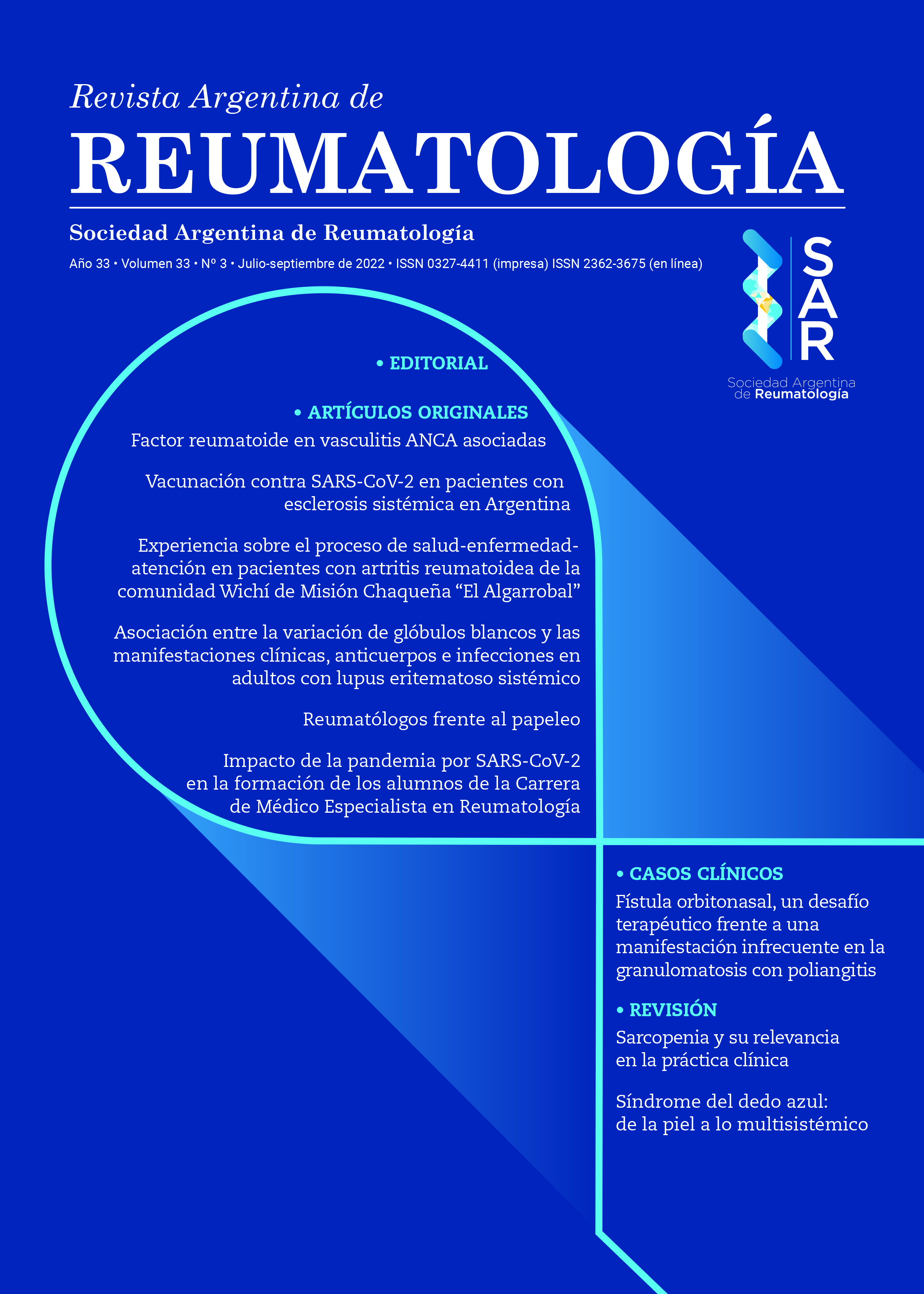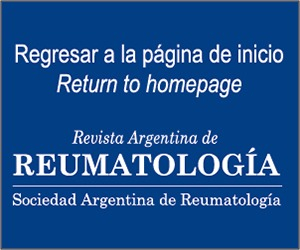Síndrome del dedo azul: de la piel a lo multisistémico
Resumen
El signo del dedo azul (SDA) es una condición poco frecuente causada principalmente por la oclusión de la vasculatura periférica. Clínicamente puede manifestarse como una coloración azulada o eritrocianótica en uno o varios dedos en ausencia de traumatismo y condiciones propias de congelación. Las etiologías son múltiples e incluyen obstrucción del flujo arterial, disminución del flujo venoso y alteración en la viscosidad sanguínea. La importancia de reconocer el signo como motivo de consulta radica en encaminar un diagnóstico temprano e instaurar un tratamiento que evite la evolución natural de la enfermedad hacia la necrosis, amputación o muerte del paciente. Proponemos un algoritmo diagnóstico para reconocer los elementos de la historia clínica que guíen la etiología y los paraclínicos disponibles desde el Servicio de Urgencias.Citas
I. Feder W. Purple toes. An uncommon sequela of oral coumarin drug therapy. Ann Intern Med 1961 Dec 1;55(6):911. Disponible en: http://annals.org/article.aspx?doi=10.7326/0003-4819-55-6-911.
II. Cortez-Franco F. Síndrome del dedo azul. Dermatología Perú 2013;23.
III. Narváez J, Bianchi M, Santo P, Castellví I. Síndrome del dedo azul. Vol. 12, Seminarios de la Fundación Española de Reumatología 2011;12:2-9.
IV. García-Donoso C, Martínez-Moran C, Borbujo JM. Síndrome (o signo) del dedo azul. Más Dermatología 2010;10:4-13. Disponible en: http://www.masdermatologia.com.
V. Brown PJ, Zirwas MJ, English JC. The purple digit: An algorithmic approach to diagnosis. Am J Clin Dermatol 2010 Apr;11(2):103-16. Disponible en: http://link.springer.com/10.2165/11530180-000000000-00000.
VI. Hirschmann JV, Raugi GJ. Blue (or purple) toe syndrome. J Am Acad Dermatol 2009 Jan;60(1):1-20; 21-2. Disponible en: http://www.ncbi.nlm.nih.gov/pubmed/19103358.
VII. Khaira HS, Rittoo D, Vohra RK, Smith SRG. The non-ischaemic blue finger. Ann R Coll Surg Engl 2001;83(3):154-7.
VIII. Parra-Izquierdo V, Aguirre HD, Agudelo N, Cuervo FM, Peñaranda E. Blue finger syndrome: case reports. Revista Colombiana de Reumatología 2018 Oct 1;25(4):292-7.
IX. Rodríguez-Criollo JA, Jaramillo-Arroyave D. Fenómeno de Raynaud. Revista de la Facultad de Medicina 2015 Feb 12;62(3):455-64. Disponible en: http://www.revistas.unal.edu.co/index.php/revfacmed/article/view/38934.
X. Herrero C, Guilabert A, Mascaró-Galy JM. Livedo reticularis de las piernas: Metodología de diagnóstico y tratamiento. Actas Dermosifiliogr 2008 Oct;99(8):598-607. Disponible en: https://linkinghub.elsevier.com/retrieve/pii/S0001731008747562.
XI. Gertz MA. Acute hyperviscosity: syndromes and management. Blood 2018 Sep 27;132(13):1379-85. Disponible en: https://ashpublications.org/blood/article/132/13/1379/105715/Acute-hyperviscosity-syndromes-and-management.
XII. Nader E, Skinner S, Romana M, Fort R, Lemonne N, Guillot N, et al. Blood rheology: key parameters, impact on blood flow, role in sickle cell disease and effects of exercise. Front Physiol 2019 Oct 17;10. Disponible en: https://www.frontiersin.org/article/10.3389/fphys.2019.01329/full.
XIII. Gardella L, Faulk J. Phlegmasia alba and cerulea dolens. Stat Pearls 2022. Disponible en: https://www.ncbi.nlm.nih.gov/books/NBK563137/.
XIV. Fukumoto Y, Tsutsui H, Tsuchihashi M, Masumoto A, Takeshita A. The incidence and risk factors of cholesterol embolization syndrome, a complication of cardiac catheterization: A prospective study. J Am Coll Cardiol 2003;42(2):211-6. Disponible en: http://dx.doi.org/10.1016/S0735-1097(03)00579-5
XV. Bashore TM, Gehrig T. Cholesterol emboli after invasive cardiac procedures. J Am Coll Cardiol 2003;42(2):217-8. Disponible en: http://dx.doi.org/10.1016/S0735-1097(03)00587-4.
XVI. Thurlbeck WM, Castleman B. Atheromatous emboli to the kidneys after aortic surgery. New England Journal of Medicine 1957 Sep 5;257(10):442-7. Disponible en: http://www.nejm.org/doi/abs/10.1056/NEJM195709052571002.
XVII. Cross SS. How common is cholesterol embolism? J Clin Pathol 1991 Oct 1;44(10):859-61. Disponible en: http://jcp.bmj.com/cgi/doi/10.1136/jcp.44.10.859.
XVIII. Keeling I. Cardiac myxomas: 24 years of experience in 49 patients. European Journal of Cardio-Thoracic Surgery 2002 Dec;22(6):971-7. Disponible en: https://academic.oup.com/ejcts/article-lookup/doi/10.1016/S1010-7940(02)00592-4.
XIX. Kuon E, Kreplin M, Weiss W, Dahm JB. The challenge presented by right atrial myxoma. Herz 2004 Nov;29(7):702-9. Disponible en: http://link.springer.com/10.1007/s00059-004-2571-7.
XX. Pinede L, Duhaut P, Loire R. Clinical presentation of left atrial cardiac myxoma. Medicine 2001 May;80(3):159-72. Disponible en: http://journals.lww.com/00005792-200105000-00002.
XXI. Selton-Suty C, Célard M, le Moing V, Doco-Lecompte T, Chirouze C, Iung B, et al. Preeminence of Staphylococcus aureus in infective endocarditis: A 1-year population-based survey. Clinical Infectious Diseases 2012 May 1;54(9):1230-9. Disponible en: https://academic.oup.com/cid/article-lookup/doi/10.1093/cid/cis199.
XXII. Wang A, Gaca JG, Chu VH. Management considerations in infective endocarditis. JAMA 2018 Jul 3;320(1):72. Disponible en: http://jama.jamanetwork.com/article.aspx?doi=10.1001/jama.2018.7596.
XXIII. Murdoch DR. Clinical presentation, etiology, and outcome of infective endocarditis in the 21st Century. Arch Intern Med 2009 Mar 9;169(5):463. Disponible en: http://archinte.jamanetwork.com/article.aspx?doi=10.1001/archinternmed.2008.603.
XXIV. Bussani R, De-Giorgio F, Pesel G, Zandonà L, Sinagra G, Grassi S, et al. Overview and comparison of infectious endocarditis and non-infectious endocarditis. A review of 814 autoptic cases. In Vivo (Brooklyn) 2019 Aug 30;33(5):1565-72. Disponible en: http://iv.iiarjournals.org/lookup/doi/10.21873/invivo.11638.
XXV. Vlachostergios PJ, Daliani DD, Dimopoulos V, Patrikidou A, Voutsadakis IA, Papandreou CN. Nonbacterial thrombotic (Marantic) endocarditis in a patient with colorectal cancer. Onkologie 2010;33(8):3-3. Disponible en: https://www.karger.com/Article/FullText/317342.
XXVI. Singh V, Bhat I, Havlin K. Marantic endocarditis (NBTE) with systemic emboli and paraneoplastic cerebellar degeneration: uncommon presentation of ovarian cancer. J Neurooncol 2007 May 5;83(1):81-3. Disponible en: https://link.springer.com/10.1007/s11060-006-9306-y.
XXVII. Graus F, Rogers LR, Posner JB. Cerebrovascular complications in patients with cancer. Medicine 1985 Jan;64(1):16-35. Disponible en: http://journals.lww.com/00005792-198501000-00002.
XXVIII. Moyssakis I, Tektonidou MG, Vasilliou VA, Samarkos M, Votteas V, Moutsopoulos HM. Libman-Sacks endocarditis in systemic lupus erythematosus: prevalence, associations, and evolution. Am J Med 2007 Jul;120(7):636-42. Disponible en: https://linkinghub.elsevier.com/retrieve/pii/S000293430700160X.
XXIX. Cervera R, Piette JC, Font J, Khamashta MA, Shoenfeld Y, Camps MT, et al. Antiphospholipid syndrome: Clinical and immunologic manifestations and patterns of disease expression in a cohort of 1,000 patients. Arthritis Rheum 2002 Apr;46(4):1019-27. Disponible en: https://onlinelibrary.wiley.com/doi/10.1002/art.10187.
XXX. George JN. The remarkable diversity of thrombotic thrombocytopenic purpura: a perspective. Blood Adv 2018 Jun 26;2(12):1510-6. Disponible en: https://ashpublications.org/bloodadvances/article/2/12/1510/15905/The-remarkable-diversity-of-thrombotic.
XXXI. Hassan A, Iqbal M, George JN. Additional autoimmune disorders in patients with acquired autoimmune thrombotic thrombocytopenic purpura. Am J Hematol 2019 Jun;94(6):E172-4. Disponible en: https://onlinelibrary.wiley.com/doi/10.1002/ajh.25466.
XXXII. Nokes T, George JN, Vesely SK, Awab A. Pulmonary involvement in patients with thrombotic thrombocytopenic purpura. Eur J Haematol 2014 Feb;92(2):156-63. Disponible en: https://onlinelibrary.wiley.com/doi/10.1111/ejh.12222.
XXXIII. Poszepczynska-Guigné E, Viguier M, Chosidow O, Orcel B, Emmerich J, Dubertret L. Paraneoplastic acral vascular syndrome: Epidemiologic features, clinical manifestations, and disease sequelae. J Am Acad Dermatol 2002 Jul;47(1):47-52. Disponible en: https://linkinghub.elsevier.com/retrieve/pii/S0190962202000166.
XXXIV. Buggiani G, Krysenka A, Grazzini M, Vašků V, Hercogová J, Lotti T. Paraneoplastic vasculitis and paraneoplastic vascular syndromes. Dermatol Ther 2010 Nov;23(6):597-605. Disponible en: https://onlinelibrary.wiley.com/doi/10.1111/j.1529-8019.2010.01367.x.
XXXV. Criado PR, Abdalla BMZ, de Assis IC, van Blarcum de Graaff Mello C, Caputo GC, Vieira IC. Are the cutaneous manifestations during or due to SARS-CoV-2 infection/COVID-19 frequent or not? Revision of possible pathophysiologic mechanisms. Inflammation Research 2020 Aug 2;69(8):745-56. Disponible en: https://link.springer.com/10.1007/s00011-020-01370-w.
XXXVI. Hartmann P, Mohokum M, Schlattmann P. The association of Raynaud syndrome with thromboangiitis obliterans. A meta-analysis. Angiology 2012 May 6;63(4):315-9. Disponible en: http://journals.sagepub.com/doi/10.1177/0003319711414868.
XXXVII. Dargon PT, Landry GJ. Buerger’s disease. Ann Vasc Surg 2012 Aug;26(6):871-80. Disponible en: https://linkinghub.elsevier.com/retrieve/pii/S0890509611005097.
XXXVIII. Pagnoux C, Seror R, Henegar C, Mahr A, Cohen P, le Guern V, et al. Clinical features and outcomes in 348 patients with polyarteritis nodosa: A systematic retrospective study of patients diagnosed between 1963 and 2005 and entered into the French vasculitis study group database. Arthritis Rheum 2010 Feb;62(2):616-26. Disponible en: https://onlinelibrary.wiley.com/doi/10.1002/art.27240.
XXXIX. Guillevin L, Mahr A, Callard P, Godmer P, Pagnoux C, Leray E, et al. Hepatitis B virus-associated polyarteritis nodosa. Medicine 2005 Sep;84(5):313-22. Disponible en: https://journals.lww.com/00005792-200509000-00006.
XL. Ramos-Casals M, Muñoz S, Medina F, Jara LJ, Rosas J, Calvo-Alen J, et al. Systemic autoimmune diseases in patients with hepatitis C virus infection: characterization of 1020 Cases (The HISPAMEC Registry). J Rheumatol 2009 Jul;36(7):1442-8. Disponible en: http://www.jrheum.org/lookup/doi/10.3899/jrheum.080874.
XLI. Hasler P, Kistler H, Gerber H. Vasculitides in hairy cell leukemia. Semin Arthritis Rheum 1995 Oct;25(2):134-42. Disponible en: https://linkinghub.elsevier.com/retrieve/pii/S0049017295800263.
XLII. Kato T, Fujii K, Ishii E, Wada R, Hidaka Y. A case of polyarteritis nodosa with lesions of the superior mesenteric artery illustrating the diagnostic usefulness of three-dimensional computed tomographic angiography. Clin Rheumatol 2005 Dec 26;24(6):628-31. Disponible en: http://link.springer.com/10.1007/s10067-005-1128-3.
XLIII. Schmidt WA. Use of imaging studies in the diagnosis of vasculitis. Curr Rheumatol Rep 2004 Jun;6(3):203-11. Disponible en: http://link.springer.com/10.1007/s11926-004-0069-1.
XLIV. Ntatsaki E, Mooney J, Scott DGI, Watts RA. Systemic rheumatoid vasculitis in the era of modern immunosuppressive therapy. Rheumatology 2014 Jan 1;53(1):145-52. Disponible en: https://academic.oup.com/rheumatology/article-lookup/doi/10.1093/rheumatology/ket326.
XLV. Lokineni S, Mohamed A, Teja-Boppana LK, Garg M. Rheumatoid vasculitis as an initial presentation of rheumatoid arthritis. Eur J Case Rep Intern Med 2021 Apr 29;8(4). Disponible en: https://www.ejcrim.com/index.php/EJCRIM/article/view/2561.
XLVI. Kishore S, Maher L, Majithia V. Rheumatoid vasculitis: a diminishing yet devastating menace. Curr Rheumatol Rep 2017 Jul 19;19(7):39. Disponible en: http://link.springer.com/10.1007/s11926-017-0667-3.
XLVII. Allanore Y, Simms R, Distler O, Trojanowska M, Pope J, Denton CP, et al. Systemic sclerosis. Nat Rev Dis Primers 2015 Dec 17;1(1):15002. Disponible en: http://www.nature.com/articles/nrdp20152
XLVIII. Denton CP, Krieg T, Guillevin L, Schwierin B, Rosenberg D, Silkey M, et al. Demographic, clinical and antibody characteristics of patients with digital ulcers in systemic sclerosis: data from the DUO Registry. Ann Rheum Dis 2012 May;71(5):718-21. Disponible en: https://ard.bmj.com/lookup/doi/10.1136/annrheumdis-2011-200631.
XLIX. Federman DG, Valdivia M, Kirsner RS. Syphilis presenting as the “blue toe syndrome”. Arch Intern Med 1994 May 9;154(9):1029-31. Disponible en: http://www.ncbi.nlm.nih.gov/pubmed/8179446.
L. Nigwekar SU, Thadhani R, Brandenburg VM. Calciphylaxis. Ingelfinger JR, editor. New England Journal of Medicine 2018 May 3;378(18):1704-14. Disponible en: http://www.nejm.org/doi/10.1056/NEJMra1505292.
LI. Hedrich CM, Fiebig B, Hauck FH, Sallmann S, Hahn G, Pfeiffer C, et al. Chilblain lupus erythematosus. A review of literature. Clin Rheumatol 2008 Aug 10;27(8):949-54. Disponible en: http://link.springer.com/10.1007/s10067-008-0942-9.
LII. Rustin MHA, Newton JA, Smith NP, Dowd PM. The treatment of chilblains with nifedipine: the results of a pilot study, a double‐blind placebo‐controlled randomized study and a long‐term open trial. British Journal of Dermatology 1989 Jul 29;120(2):267-75. Disponible en: https://onlinelibrary.wiley.com/doi/10.1111/j.1365-2133.1989.tb07792.x.
LIII. Down PM, Rustin MHA, Lanigan S. Nifedipine in the treatment of chilblains. Br Med J (Clin Res Ed) 1986 Oct 11;293(6552):923-4. Disponible en: https://www.bmj.com/lookup/doi/10.1136/bmj.293.6552.923-a.
LIV. Guadagni M, Nazzari G. Acute perniosis in elderly people. A predictive sign of systemic disease? Acta Dermato Venereol 2010;90(5):545-6. Disponible en: https://www.medicaljournals.se/acta/content/abstract/10.2340/00015555-0918.
LV. Finke-Fyffe S, Regan J, Golan J. Hypothenar hammer syndrome. J Am Acad Physician Assist 2019 Sep;32(9):33-5. Disponible en: https://journals.lww.com/10.1097/01.JAA.0000578972.17680.39.
LVI. McCready RA, Bryant MA, Divelbiss JL. Combined thenar and hypothenar hammer syndromes: Case report and review of the literature. J Vasc Surg 2008 Sep;48(3):741-4. Disponible en: https://linkinghub.elsevier.com/retrieve/pii/S0741521408005053.
LVII. Blum AG, Zabel JP, Kohlmann R, Batch T, Barbara K, Zhu X, et al. Pathologic conditions of the hypothenar eminence: evaluation with multidetector CT and MR imaging. RadioGraphics 2006 Jul;26(4):1021-44. Disponible en: http://pubs.rsna.org/doi/10.1148/rg.264055114.
LVIII. Picón Jaimes YA, Orozco Chinome JE, Molina-Franky J. Hematoma digital espontaneo, síndrome de Achenbach. Rev Fac Cienc Med Cordoba 2019 Dec 11;76(4):257-60.
LIX. Pérez-Abdala JI, Sánchez-Saba J, Zaidenberg EE, Gallucci G, Boretto J, de Carli P, et al. Dedo azul agudo idiopático no isquémico: síndrome de Achenbach. Presentación de un caso y revisión bibliográfica. Revista de la Asociación Argentina de Ortopedia y Traumatología 2021 Oct 10;86(5):645-50. Disponible en: https://raaot.org.ar/index.php/AAOTMAG/article/view/1182.
LX. Jiménez PR, Ocampo MI, Castañeda-Cardona C, Rosselli D. Achenbach’s syndrome. Case report and systematic review of the literature. Revista Colombiana de Reumatología (English Edition) 2017 Oct;24(4):230-6.
LXI. McGrath MA, Tracy GD, Lord RSA, Penny R. Peripheral ischaemia caused by blood hyperviscosity. Australian and New Zealand Journal of Surgery 1973 Sep;43(2):109-13.
LXII. Ghetie D, Mehraban N, Sibley CH. Cold hard facts of cryoglobulinemia. Rheumatic Disease Clinics of North America 2015 Feb;41(1):93-108. Disponible en: https://linkinghub.elsevier.com/retrieve/pii/S0889857X14000970
LXIII. Kaufman JA, Lee MJ. Vascular and interventional radiology. Elsevier Saunders 2014.
LXIV. Sibley RC, Reis SP, MacFarlane JJ, Reddick MA, Kalva SP, Sutphin PD. Noninvasive physiologic vascular studies. A guide to diagnosing peripheral arterial disease. RadioGraphics 2017 Jan;37(1):346-57. Disponible en: http://pubs.rsna.org/doi/10.1148/rg.2017160044.
Derechos de autor 2022 A nombre de los autores. Derechos de reproducción: Sociedad Argentina de Reumatología

Esta obra está bajo licencia internacional Creative Commons Reconocimiento-NoComercial-SinObrasDerivadas 4.0.






